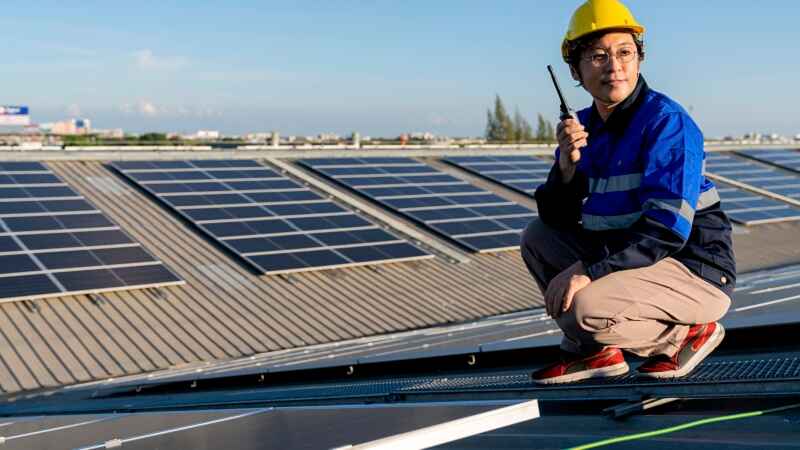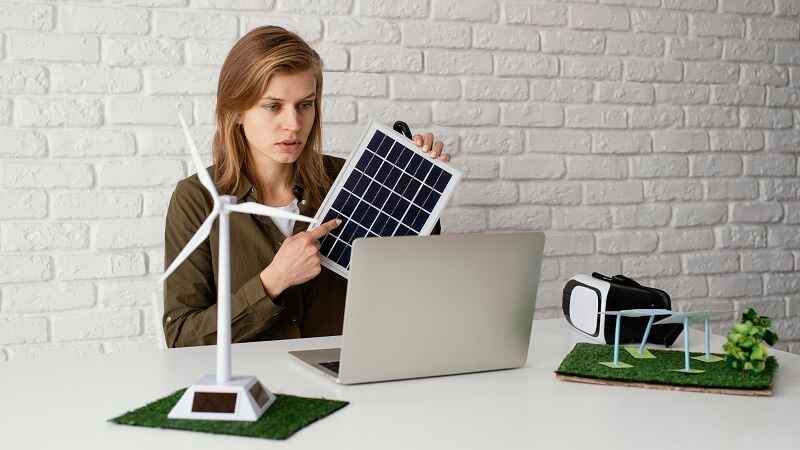In the modern world, where energy demand continues to rise, finding renewable and sustainable power sources has become essential. Among the most promising solutions is solar energy, captured and converted through solar panels. These panels have transformed how homes, businesses, and industries generate electricity — offering a cleaner, cost-effective, and eco-friendly alternative to fossil fuels.
This article explains everything you need to know about solar panels — how they work, their types, benefits, costs, and how they are shaping the future of global energy.
1. What Are Solar Panels?
Solar panels, also known as photovoltaic (PV) panels, are devices that convert sunlight directly into electricity. They consist of multiple solar cells made primarily of silicon, which captures solar energy and turns it into usable electrical power.
The main goal of solar panels is to reduce reliance on non-renewable energy sources and lower carbon emissions. Whether installed on rooftops, open fields, or large solar farms, these panels provide sustainable energy that can power everything from small homes to large industries.
2. How Do Solar Panels Work?
Understanding how solar panels work helps explain why they’re so efficient and reliable. The process involves three main steps:
2.1 Absorption of Sunlight
When sunlight hits the surface of a solar panel, the solar cells absorb the energy from photons (light particles).
2.2 Conversion into Electricity
This energy knocks electrons loose within the silicon cells, creating an electric current. This process is called the photovoltaic effect, which produces direct current (DC) electricity.
2.3 Conversion to Usable Power
Since most homes and appliances use alternating current (AC), an inverter converts the DC electricity from the solar panels into AC power, making it usable for everyday purposes.
The system can then power your home directly or store excess energy in solar batteries for later use.
3. Types of Solar Panels
There are several types of solar panels available today, each with unique features, efficiency levels, and applications.
3.1 Monocrystalline Solar Panels
-
Made from a single continuous crystal structure.
-
Known for high efficiency (15–22%) and long lifespan.
-
Work well in limited spaces due to their compact design.
-
Typically black in color and more expensive than other types.
3.2 Polycrystalline Solar Panels
-
Made from multiple silicon crystals melted together.
-
Slightly less efficient (13–17%) but more cost-effective.
-
Recognizable by their blue color and speckled appearance.
3.3 Thin-Film Solar Panels
-
Made from layers of photovoltaic materials on glass, plastic, or metal substrates.
-
Lightweight, flexible, and ideal for curved surfaces or portable uses.
-
Less efficient (10–12%) but cheaper and easier to install.
3.4 Bifacial Solar Panels
-
Capture sunlight from both sides, increasing total energy output.
-
Often used in commercial and utility-scale installations.
4. Benefits of Solar Panels
Solar panels provide numerous advantages, making them one of the most popular renewable energy options worldwide.
4.1 Renewable and Sustainable
Solar energy is an infinite resource. As long as the sun exists, humans can generate clean power without depleting natural resources.
4.2 Environmentally Friendly
Unlike coal or gas, solar panels produce no greenhouse gases or air pollution, reducing your carbon footprint and helping combat climate change.
4.3 Cost Savings
After installation, solar panels can significantly reduce or even eliminate electricity bills. Many users generate more power than they consume, allowing them to sell excess energy back to the grid (net metering).
4.4 Low Maintenance
Solar panels require minimal upkeep — periodic cleaning and routine inspections are usually enough to ensure maximum performance.
4.5 Energy Independence
By producing your own electricity, you’re less reliant on fluctuating utility prices or power outages.
4.6 Increases Property Value
Homes equipped with solar panels often have higher resale values and attract energy-conscious buyers.
5. Components of a Solar Power System
A complete solar energy system includes more than just panels. Each component plays a crucial role in energy generation and management.
-
Solar Panels: Capture sunlight and generate DC electricity.
-
Inverter: Converts DC electricity into AC power for home use.
-
Mounting System: Secures panels on roofs or ground structures.
-
Battery Storage (optional): Stores excess power for nighttime or cloudy days.
-
Charge Controller: Regulates energy flow to prevent overcharging.
-
Monitoring System: Tracks performance and energy output in real-time.

6. The Installation Process
Installing solar panels requires careful planning and professional expertise. Here’s a breakdown of the process:
6.1 Site Assessment
A technician assesses your roof’s condition, angle, shading, and orientation to determine suitability for solar installation.
6.2 System Design
Based on energy needs and roof layout, experts design a system optimized for maximum efficiency.
6.3 Permits and Approvals
Before installation, local authorities may require permits and utility company approvals.
6.4 Installation
The panels, inverter, and other components are installed, usually within a few days.
6.5 Connection to Grid
Once installed, the system is connected to the grid (or battery backup system) and tested for safety and functionality.
7. Cost of Solar Panels
The cost of solar panels depends on various factors like system size, type of panels, and location.
7.1 Average Installation Cost
In most regions, the average cost of installing solar panels ranges between $10,000 and $25,000 for residential systems before incentives.
7.2 Incentives and Rebates
Many governments offer tax credits, rebates, and grants to make solar more affordable. For instance:
-
Federal tax credits can cover up to 30% of installation costs.
-
Net metering programs allow you to sell unused electricity back to the grid.
7.3 Long-Term Savings
While the upfront cost may seem high, solar panels pay for themselves within 5–10 years through energy savings and incentives.
8. Maintenance of Solar Panels
Solar panels are durable and designed to last 25–30 years. However, proper maintenance helps ensure long-term efficiency.
8.1 Regular Cleaning
Dust, leaves, or bird droppings can block sunlight and reduce output. Cleaning the panels every few months is recommended.
8.2 Routine Inspections
Inspect electrical wiring, mounts, and inverters for wear or damage once or twice a year.
8.3 Professional Servicing
Most manufacturers offer annual maintenance contracts to ensure optimal performance and system health.
9. Solar Panels for Homes vs. Businesses
Solar energy systems are beneficial for both residential and commercial use, but the goals and setups may differ.
9.1 Residential Solar Panels
-
Installed on rooftops or open ground near homes.
-
Aim to reduce or eliminate household electricity bills.
-
Often smaller systems (3–10 kW).
9.2 Commercial Solar Panels
-
Installed on office buildings, warehouses, or industrial spaces.
-
Designed to meet large energy demands.
-
Often include large-scale battery storage and monitoring systems.
10. Environmental Impact of Solar Energy
Solar panels contribute significantly to environmental protection.
-
Reduced Carbon Emissions: A single home solar system can offset 3–4 tons of CO₂ annually.
-
Reduced Fossil Fuel Use: Solar energy decreases dependency on coal, oil, and gas.
-
Cleaner Air and Water: Solar energy production doesn’t release pollutants or require water for cooling.
Even though panel production involves some resource use, the environmental benefits far outweigh the impact.
11. Challenges of Solar Panels
While solar panels offer many benefits, they also have some limitations.
11.1 Weather Dependence
Solar panels perform best in sunny conditions and may produce less power during cloudy or rainy days.
11.2 High Initial Cost
Despite declining prices, installation costs remain a barrier for some homeowners.
11.3 Energy Storage Costs
Solar batteries add to the system cost, though they ensure continuous power during nights or outages.
11.4 Space Requirements
Larger systems require adequate roof or land space for optimal installation.
12. Future Trends in Solar Technology
The solar industry is rapidly evolving with new technologies and innovations that promise greater efficiency and affordability.
12.1 Perovskite Solar Cells
These emerging materials offer higher efficiency at lower production costs.
12.2 Solar Roof Tiles
Companies like Tesla are introducing solar-integrated roofing materials that blend seamlessly into homes.
12.3 Floating Solar Farms
Floating panels on water bodies reduce land use and improve cooling efficiency.
12.4 Energy Storage Innovations
New battery technologies like solid-state and lithium-sulfur promise longer life and lower costs.
12.5 AI and IoT Integration
Smart solar systems can optimize energy production using real-time weather and usage data.
13. Solar Panels and Government Policies
Governments worldwide are promoting solar adoption through policies, subsidies, and awareness campaigns.
-
Feed-in Tariffs: Guarantee fixed payments for electricity generated from solar.
-
Renewable Portfolio Standards: Encourage utilities to source energy from renewables.
-
Solar Incentive Programs: Reduce installation costs and promote green energy transition.
Such initiatives make solar power more accessible to individuals and businesses alike.
14. The Economic Impact of Solar Energy
Solar energy not only benefits the environment but also boosts economies by creating jobs and driving innovation.
-
Job Creation: Solar panel manufacturing, installation, and maintenance create millions of jobs globally.
-
Reduced Import Dependency: Countries can rely less on imported fossil fuels.
-
Local Economic Growth: Solar projects bring investment and development to rural areas.
15. Conclusion
Solar panels represent the future of energy — clean, renewable, and sustainable. By capturing the sun’s limitless power, they reduce electricity costs, support environmental goals, and promote energy independence.
While the initial investment may seem significant, the long-term savings, government incentives, and positive environmental impact make solar panels a smart choice for both homes and businesses More Read
